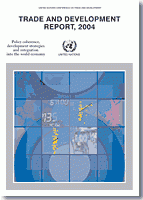
Global economic recovery is underway. But will it be sustained, and will it benefit all countries? There are considerable downside risks stemming from oil prices and exchange rates. Moreover, both the sources and incidence of growth are unequally distributed around the globe.
Rising United States deficits and rapidly expanding demand in East and South Asia have been the main stimulus for the world economy. What are the implications of this pattern for current trends and future prospects in the world economy?
Greater openness to international trade and finance has not enabled developing countries to establish a virtuous interaction between external financing, domestic investment and export growth. The TDR 2004 argues that, to achieve this, a feasible development agenda has to be based on the concept of "coherence". Here, a fundamental question is how to address the problems of trade imbalances originating in the monetary and financial system.
The advantages of a currency devaluation for one country have to be balanced against the disadvantages for others. UNCTAD warns that attempts by many countries to keep their currencies undervalued could end up in a race to the bottom - or in competitive devaluations - that could be as disastrous for the world economy as the experience of the 1930s. Since changes in the exchange rate that imply deviation from purchasing-power parity affect international trade in a way comparable to tariffs and export subsidies or duties, such changes should also be governed by multilateral regulations, UNCTAD suggests.


